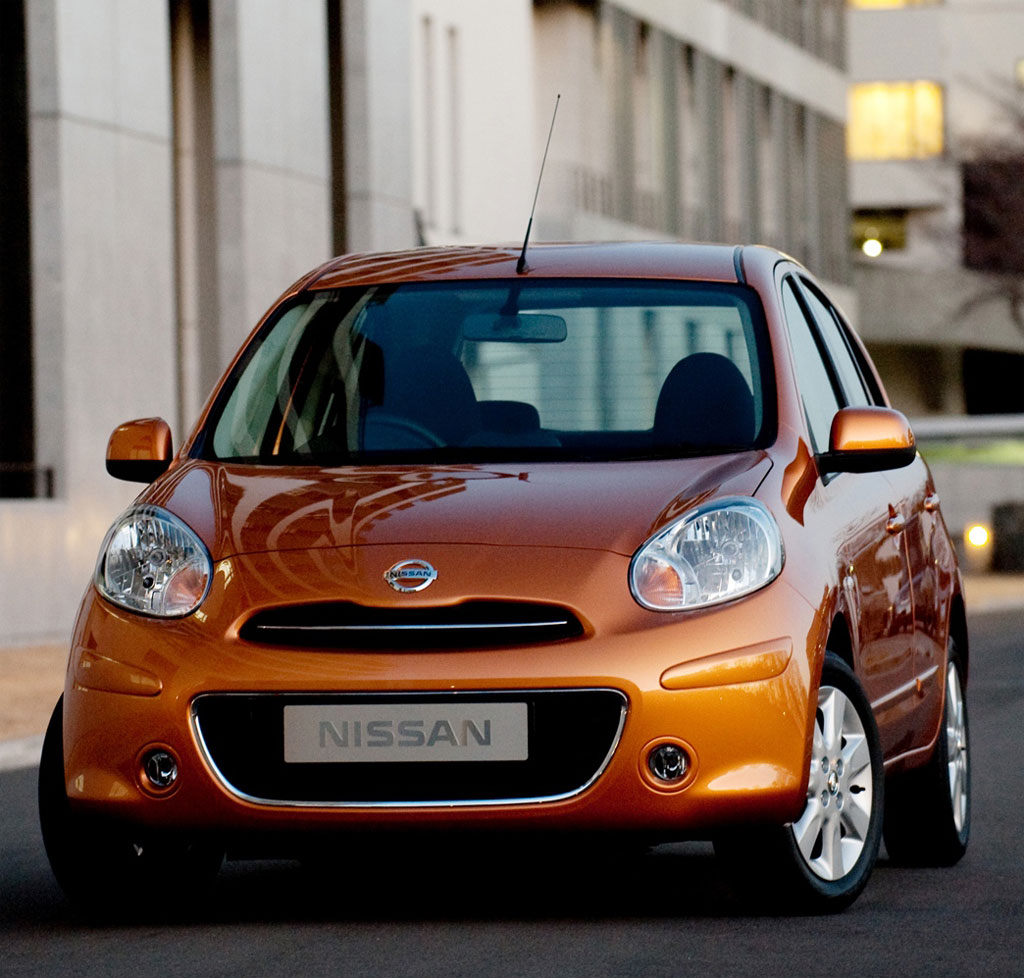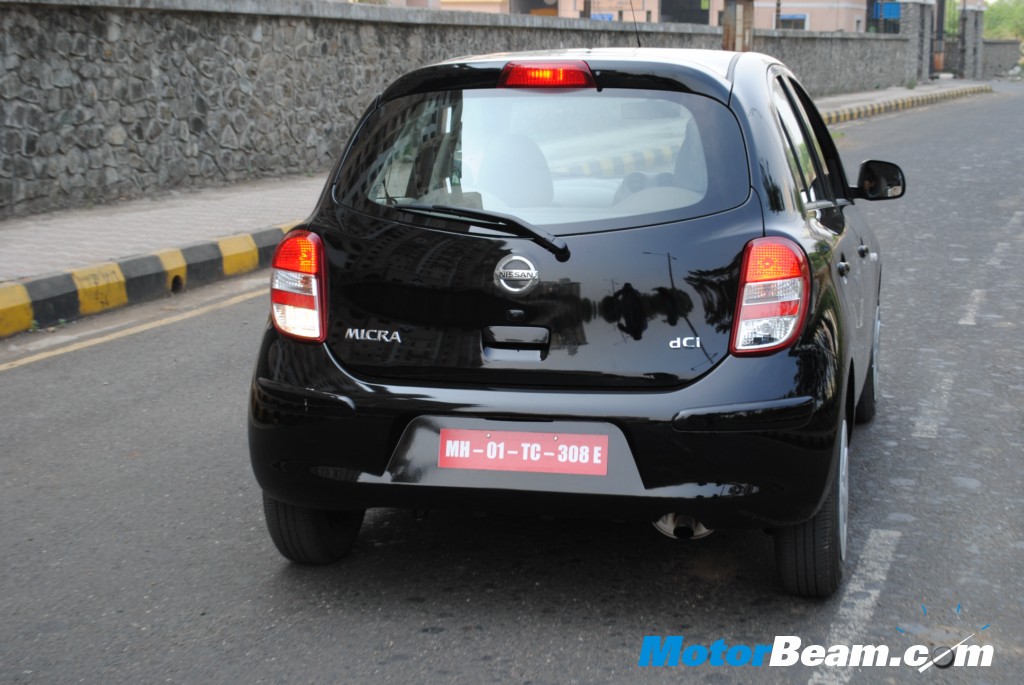The original Micra (chassis name K10) was introduced in October 1982 as a challenger to the highly successful Honda City.[citation needed] It was intended to replace the Nissan Cherry as the company's competitor in the supermini sector, as the Cherry model itself had progressively become larger with each successive generation. It was introduced in the European market in 1983, and in the Canadian market in 1984. Although Nissan was slowly phasing out the Datsun name, a small "Datsun" (ダットサン, Dattosan?) appeared on the tailgate for the first two years, and in some European markets, the car was known as the "Datsun-Nissan Micra". The Datsun badges had disappeared completely by the end of 1984. The Micra was initially available with an extremely refined all-aluminium MA10S SOHC engine.

Nissan-Micra-Diesel-5

The Nissan Micra Diesel is
The model was revised in June 1985, identifiable by the slightly larger rear lamp clusters. The Japanese market saw the debut of the first Micra Turbo/MA10ET, where Nissan grafted a turbocharger to the small 1.0 L engine. Another facelift came in March 1989, which consisted of some minor upgrades such as deeper bumpers, a new front grille, minor interior details, and headlight changes. It also saw the introduction of an electronically controlled carburettor, the larger MA12 1.2 L engine with 60 PS (44 kW/59 hp) and a 5-door hatchback version.

Nissan Micra Exteriors
In 1988, Nissan launched a limited 10,000 unit run of its homologated Nissan 1989 Micra Superturbo (EK10GFR/GAR). Both this and the 1988 Micra R (EK10FR) featured the same highly advanced sequential compound charged (supercharger plus turbocharger) engine in an all-aluminium straight-4 930 cc 8-valve 4-cylinder Nissan MA MA09ERT unit that produced 110 PS JIS (81 kW/108 hp) at 6400 rpm. This car came with either a 3-speed automatic or 5-speed manual gearbox with viscous limited slip differential, as well as options such as air conditioning and electric mirrors. The Micra Superturbo still holds the crown for the fastest production Micra in Nissan's history, with factory performance figures of 7.7 seconds to go from 0 to 100 km/h (62 mph) and 15.5 seconds to run a quarter mile. It has a top speed of 180 km/h (112 mph).

Nissan Micra Diesel Price
The Micra's chassis spawned a number of variations. The Be-1 (BK10), launched at the Tokyo Motor Show in 1985 (but not sold until 1987), was a limited edition model with a more rounded bodyshape, and only 10,000 were sold. In 1987, the canvas-topped, retro looking hatchback Pao (パオ) (PK10) was launched (also at the Tokyo Motorshow) and sold to the public in 1989; 51,657 models were sold. The canvas-topped Figaro (フィガロ) (FK10) coupé was unveiled at the same show in 1989, but not released until 1991. Because demand for the Figaro exceeded the 20,000 vehicles built, Nissan sold the car by lottery: winners could place orders for the car. Despite being a JDM-only model, the Figaro is one of the most imported models of the K10 derivatives; its popularity among numerous celebrity owners helped it earn cult status. The K10 ceased production on 21 December 1992.

Nissan Micra Diesel Nissan

2011 Nissan Micra Diesel Specs
During its lifetime, the Micra gained a good reputation for reliability and economy. In 1995, it topped the small car class in a reliability survey of four to six-year-old cars undertaken by the German Automobile Association (ADAC), with 7.5 recorded breakdowns per 1,000 vehicles for four-year-old Micras and 11.5 for six-year-old cars: this compared with 8.0 breakdowns per 1,000 cars for four-year old Volkswagen Polos and 15.3 for six-year-old Polos. (The class loser was the Fiat Uno with 20.7 breakdowns per 1,000 for four-year-old cars and 37.3 for six-year-old Unos.

Nissan Micra Diesel car,

Nissan Micra

Nissan Micra Diesel is
The second-generation K11 was built and launched in Japan in early 1992, and released in Europe in the fourth quarter of the year. It was powered by brand new all-aluminium 1.0 L (CG10DE) and 1.3 L (CG13DE) DOHC 16 valve engines, with 55 PS DIN (40 kW/54 hp) and 75 PS (55 kW/75 bhp) respectively (higher outputs in Japan), both with ECCS (Electronic Concentrated Control System) fuel injection. Power steering was an option on some models, and the equipment list included security features not usually available in this market segment: a toughened safety-cage and side-impact door beams were standard and pre-tensioning seat-belts and a driver's air-bag were optional. However, the MK2 Micra scored only a modest two stars in Euro NCAP testing in 1997. Airbags, antilock brakes, electric windows, central locking and air conditioning were available as options on some of the Micra range as it developed in its life cycle. The car soon won the European Car of the Year award for 1993 (the first Japanese car to do so) and the Good Design Award (a Trade and Industry Design award in Japan) along with the Car of the Year Japan award in 1993. This would spawn the V3 Award edition.

Nissan Micra Diesel engine

Nissan Micra Overall
After minor changes in 1996, in 1998, six years after its launch, the Micra received a facelift which saw the whole range get power steering as standard. This also saw the introduction of the Peugeot-sourced 1.5 L TUD5 Diesel engine into the Western European range.

Nissan Micra diesel

Nissan Micra Diesel 1.5 dCi

Nissan Micra 2011

Nissan Micra Diesel

Nissan Micra diesel specs

Nissan-Micra-Diesel-5

The Nissan Micra Diesel is
The model was revised in June 1985, identifiable by the slightly larger rear lamp clusters. The Japanese market saw the debut of the first Micra Turbo/MA10ET, where Nissan grafted a turbocharger to the small 1.0 L engine. Another facelift came in March 1989, which consisted of some minor upgrades such as deeper bumpers, a new front grille, minor interior details, and headlight changes. It also saw the introduction of an electronically controlled carburettor, the larger MA12 1.2 L engine with 60 PS (44 kW/59 hp) and a 5-door hatchback version.

Nissan Micra Exteriors
In 1988, Nissan launched a limited 10,000 unit run of its homologated Nissan 1989 Micra Superturbo (EK10GFR/GAR). Both this and the 1988 Micra R (EK10FR) featured the same highly advanced sequential compound charged (supercharger plus turbocharger) engine in an all-aluminium straight-4 930 cc 8-valve 4-cylinder Nissan MA MA09ERT unit that produced 110 PS JIS (81 kW/108 hp) at 6400 rpm. This car came with either a 3-speed automatic or 5-speed manual gearbox with viscous limited slip differential, as well as options such as air conditioning and electric mirrors. The Micra Superturbo still holds the crown for the fastest production Micra in Nissan's history, with factory performance figures of 7.7 seconds to go from 0 to 100 km/h (62 mph) and 15.5 seconds to run a quarter mile. It has a top speed of 180 km/h (112 mph).

Nissan Micra Diesel Price
The Micra's chassis spawned a number of variations. The Be-1 (BK10), launched at the Tokyo Motor Show in 1985 (but not sold until 1987), was a limited edition model with a more rounded bodyshape, and only 10,000 were sold. In 1987, the canvas-topped, retro looking hatchback Pao (パオ) (PK10) was launched (also at the Tokyo Motorshow) and sold to the public in 1989; 51,657 models were sold. The canvas-topped Figaro (フィガロ) (FK10) coupé was unveiled at the same show in 1989, but not released until 1991. Because demand for the Figaro exceeded the 20,000 vehicles built, Nissan sold the car by lottery: winners could place orders for the car. Despite being a JDM-only model, the Figaro is one of the most imported models of the K10 derivatives; its popularity among numerous celebrity owners helped it earn cult status. The K10 ceased production on 21 December 1992.

Nissan Micra Diesel Nissan

2011 Nissan Micra Diesel Specs
During its lifetime, the Micra gained a good reputation for reliability and economy. In 1995, it topped the small car class in a reliability survey of four to six-year-old cars undertaken by the German Automobile Association (ADAC), with 7.5 recorded breakdowns per 1,000 vehicles for four-year-old Micras and 11.5 for six-year-old cars: this compared with 8.0 breakdowns per 1,000 cars for four-year old Volkswagen Polos and 15.3 for six-year-old Polos. (The class loser was the Fiat Uno with 20.7 breakdowns per 1,000 for four-year-old cars and 37.3 for six-year-old Unos.

Nissan Micra Diesel car,

Nissan Micra

Nissan Micra Diesel is
The second-generation K11 was built and launched in Japan in early 1992, and released in Europe in the fourth quarter of the year. It was powered by brand new all-aluminium 1.0 L (CG10DE) and 1.3 L (CG13DE) DOHC 16 valve engines, with 55 PS DIN (40 kW/54 hp) and 75 PS (55 kW/75 bhp) respectively (higher outputs in Japan), both with ECCS (Electronic Concentrated Control System) fuel injection. Power steering was an option on some models, and the equipment list included security features not usually available in this market segment: a toughened safety-cage and side-impact door beams were standard and pre-tensioning seat-belts and a driver's air-bag were optional. However, the MK2 Micra scored only a modest two stars in Euro NCAP testing in 1997. Airbags, antilock brakes, electric windows, central locking and air conditioning were available as options on some of the Micra range as it developed in its life cycle. The car soon won the European Car of the Year award for 1993 (the first Japanese car to do so) and the Good Design Award (a Trade and Industry Design award in Japan) along with the Car of the Year Japan award in 1993. This would spawn the V3 Award edition.

Nissan Micra Diesel engine

Nissan Micra Overall
After minor changes in 1996, in 1998, six years after its launch, the Micra received a facelift which saw the whole range get power steering as standard. This also saw the introduction of the Peugeot-sourced 1.5 L TUD5 Diesel engine into the Western European range.

Nissan Micra diesel

Nissan Micra Diesel 1.5 dCi

Nissan Micra 2011
Nissan Micra Diesel

Nissan Micra diesel specs
Audi A3 flywheel
ReplyDeleteAudi A4 flywheel
Audi A6 flywheel
Audi Q3 flywheel
ReplyDeleteRenault duster shock absorbers
Renault Kwid shock absorbers
Hyundai Greta dicky shocker
Nissan Micra dicky shocker
Renault kwid dicky shocker
Renault duster dicky shocker